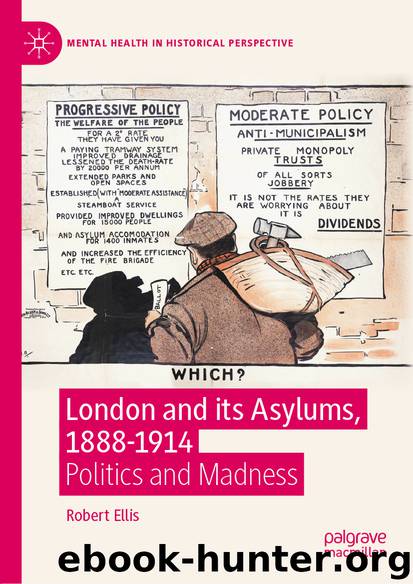London and its Asylums, 1888-1914 by Robert Ellis

Author:Robert Ellis
Language: eng
Format: epub
ISBN: 9783030444327
Publisher: Springer International Publishing
LCC and the Politics of Pathology
Just as Brudenell Carter had tried to claim some credit for the idea of Receiving Houses, he also wrote to The Times stating that the appointment of a pathologist for LCC stemmed from recommendations made by his committee.129 In response, Robert Jones , with the permission of the Chairman of the Claybury Committee, wrote, instead, to honour the work of William Collins. Jones pointed to Brudenell Carter’s association with at least one failure, while Collins himself explained that the two things were unconnected.130 Nothing, Collins remarked, was heard of Carter’s report after it had been passed back to the Council by the Asylums Committee. It was only after the election of 1892 that an ‘entirely new enquiry was set on foot’, and, as Collins pointed out, Brudenell Carter was not a member of LCC after that date.131 1892 was the date that Collins was elected, as well as the election of the second Progressive Administration and it is these factors that help to explain the development and direction of London’s pathological services in this period.
In line with what was becoming the usual practice, the Asylums Committee appointed a Pathology sub-committee to deal with the issue but, for the first time, it was made up entirely of its medical members. Doyle has explored the levels to which medical staff could influence decision-making but, just as was the case with Brudenell Carter’s committee, their relative power stemmed from their election as councillors and not from their expertise in the treatment of lunacy.132 As the names in Table 4.2 show, this committee was dominated by Progressive members and it was Collins, one of only two of its members that attended all three of its meetings who was appointed its Chairman. It is little wonder that he was described as the Committee’s ‘moving and guiding spirit’.133 With Collins in the Chair, the first task of the appointment sub-committee was to read a report by ‘Dr Alexander of Hanwell Asylum to the Hanwell sub-committee upon the question of a appointing a pathologist’.134 Following this, a list of questions were formulated for each of the medical superintendents of London’s Four County Asylums and also to the members of the sub-committee.135 Just as had been the case with Brudenell Carter’s Committee, the Pathology sub-committee engaged in a consultation exercise. Crucially, however, that consultation included LCC medical staff from the outset but, more significantly still, it had drawn its authority from the Asylums Committee itself. In this respect, it made it much more likely that any of its recommendations would be approved as they made their way through the Committee structure.Table 4.2Special sub-committee (appointment of pathologist)
Download
This site does not store any files on its server. We only index and link to content provided by other sites. Please contact the content providers to delete copyright contents if any and email us, we'll remove relevant links or contents immediately.
| Africa | Americas |
| Arctic & Antarctica | Asia |
| Australia & Oceania | Europe |
| Middle East | Russia |
| United States | World |
| Ancient Civilizations | Military |
| Historical Study & Educational Resources |
Room 212 by Kate Stewart(5035)
The Crown by Robert Lacey(4722)
Endurance: Shackleton's Incredible Voyage by Alfred Lansing(4676)
The Iron Duke by The Iron Duke(4291)
The Rape of Nanking by Iris Chang(4136)
Joan of Arc by Mary Gordon(4013)
Killing England by Bill O'Reilly(3951)
Say Nothing by Patrick Radden Keefe(3903)
I'll Give You the Sun by Jandy Nelson(3357)
Shadow of Night by Deborah Harkness(3298)
Hitler's Monsters by Eric Kurlander(3268)
Mary, Queen of Scots, and the Murder of Lord Darnley by Alison Weir(3147)
Blood and Sand by Alex Von Tunzelmann(3138)
Darkest Hour by Anthony McCarten(3070)
Eleanor & Park by Rainbow Rowell(3061)
Margaret Thatcher: The Autobiography by Thatcher Margaret(3028)
Red Famine: Stalin's War on Ukraine by Anne Applebaum(2873)
Book of Life by Deborah Harkness(2866)
The One Memory of Flora Banks by Emily Barr(2801)
